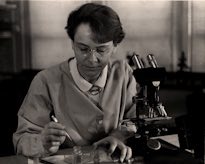America’s most distinguished cytogeneticist, Barbara McClintock she entered Cornell University in 1919 where she concentrated in plant breeding and botany in the College of Agriculture. Since the Plant Breeding department discouraged women from doing graduate work due to a lack of job prospects, she instead studied plant cytology, genetics and zoology in the Department of Botany and received her Ph.D. in 1927.
She worked at Cornell and the University of Missouri until 1942, when she secured a research position with The Carnegie Institution of Washington’s Department of Genetics at Cold Spring Harbor, New York. For the next 43 years, Dr. McClintock studied genetic mutations by examining changes in color and texture of the pigment in kernels and leaves of growing plants.
In 1950, Dr. McClintock first reported in a scientific journal that genetic information could transpose from one chromosome to another. Many scientists assumed that this unorthodox view of genes was peculiar to the corn plant and was not universally applicable to all organisms. They believed that genes usually were held in place in the chromosome like a necklace of beads.
Twenty years later, after many discoveries in molecular biology, scientists finally acknowledged Barbara McClintock’s view of genes as universal, and in 1983 she received the Nobel Prize in Physiology or Medicine for her pioneering discovery of mobile genetic elements. Her work has assisted in the understanding of human disease. “Jumping genes” help explain how bacteria are able to develop resistance to an antibiotic and there is some indication that jumping genes are involved in the transformation of normal cells to cancerous cells.

